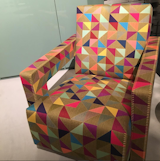A band of precast concrete, which holds a custom bench, wraps around the downstairs living area. The striped cushion fabric was purchased in Antwerp. A wood-framed AP71 lounge chair by Hans Wegner and a seat by Wim Rietveld, the son of famed Dutch designer Gerrit Rietveld, outfit the space. Underfloor heating installed throughout the house allows for a flexible layout: “There aren’t any radiators cluttering up the rooms,” Jeffries explains.
Rietveld Schröder House, Gerrit Rietveld, 1924, Utrecht, The Netherlands.
An incongruous end to a block of traditional brick row houses on the edge of Utrecht, the Rietveld Schröder House of 1924 is recognized as a UNESCO World Heritage site for its radical innovation in domestic architecture. Developed by renowned Dutch architect and furniture designer Gerrit Rietveld for his client Truus Schröder-Schräder, the residence is the first large-scale declaration of De Stijl design ideals. The house is now maintained by the Centraal Museum Foundation, but Rietveld’s experimental use of materials, combined with the wear-and-tear from thousands of visitors each year, creates a demanding maintenance schedule. A Getty grant will support the development of a conservation management plan that balances sensitivity to the architect’s design intent with the building’s complex conservation needs. The project includes an oral history that will capture the knowledge of one of Rietveld’s assistants, who played a pivotal role in past interventions to the home, as well as the broad dissemination of the project research through a free online publication. Grant support: $140,000
50 years
Gerrit Rietveld’s Steltman chair has recently been reissued by Rietveld Originals to mark its fiftieth anniversary. The chair, originally designed to seat engaged couples as they choose rings at the Steltman jewelry house in The Hague, was reproduced based on Rietveld’s drawings and one of the two original chairs, currently housed in Amsterdam’s Rijksmuseum. Photo courtesy of Rietveld Originals.
Architect William Massie built a hybrid prefab home for vintage retailer Greg Wooten, who handled the interiors. In the living room is a 1950s Franco Albini rattan chair, a Crate chair designed by Gerrit Rietveld in 1934, and a 1970s sofa by Edward Axel Roffman. The tall ceramic piece is by Bruno Gambone.
Cortney: How to Construct Rietveld Furniture
I've recently entered a DIY-inspired phase right now. I see something cool and I begin analyzing exactly how I could make one for myself. So it doesn't surprise me that the book
How to Construct Rietveld Furniture promptly made it onto my svpply wishlist.
In the living room, a black Carrara floor lamp by Alfredo Häberli for Luceplan echoes the shape of the column. The Jean Prouvé Trapèze desk is topped with a Kelvin LED lamp designed by Antonio Citterio with Toan Nguyen for Flos. Books rest on a wood Zig Zag chair by Gerrit Rietveld.
Renting the apartment was a dream come true for Claus, who founded his firm in Amsterdam, but had always wanted to live in Paris. “Why? Anyone who’s visited the city will know the answer—it’s self-explanatory,” he says. He currently spends most weekends in his second home—“I couldn’t live here permanently; I’d find it too overpowering,” Claus says. He frequently throws parties for fellow design aficionados. “It’s fantastic for entertaining, simply because most of my friends and contacts, as architecture fans, are thrilled to have a chance to spend time here.”
The Dutch architect and cabinetmaker Gerrit Rietveld designed the precursor to his famous Red Blue Chair in 1918/1919. He submitted the unpainted model to an exhibition at the Museum for Applied Arts in Haarlem, which included a competition for the best design for a simple lounge chair that could be manufactured for less than 35 guilders—roughly $20. The resulting design is an open spatial composition, corresponding to the principles of the De Stijl movement, of which Rietveld was a member. “The construction helps to interconnect the components without mutilating them or allowing one to dominate the other, with the resulting effect that the whole stands free and clear within the space and the form is further emphasized by the material,” he says.
Curated by Rietveld Landscape, 'Vacant NL—Where Architecture Meets Ideas' throws the potential of temporarily unoccupied buildings all over the Netherlands into the spotlight. Diverse building typologies, conditions of use, and their geographic locations were all catalogued and proposed for new spaces to push forward Netherlands' creative economy.
In 2006, Claus—director of Claus en Kaan Architecten, one of the Netherlands’ top architectural practices—finally got inside Perret’s apartment. He was duly impressed. “It’s the sheer abundance with which limited materials are used here that first struck me,” he says. “The wall-to-wall French oak paneling, combined with materials that were ahead of their time—columns made not from marble but from stone-blasted concrete, the extraordinary round plaster ceiling inset, and the fiber-wood paneling—and his attention to the tiniest of details.”
He tracked down the organization that owns the apartment, the Association Auguste Perret, to see if he and his wife could rent the unit as a pied-à-terre. To his surprise, they said yes.
In the dining room, a marble-topped table by Eero Saarinen is ringed with Eames wire chairs. Through oak accordion doors, the atrium beckons with red Utrecht armchairs by Gerrit Rietveld and a yellow Diana table by Konstantin Grcic.
Gravity Stool by Jólan van der Wiel received the BIO 23 student work award. The look of this wind-swept seating design was created by combining iron filings, resin, and the power of magnetism. A much talked about submission in the "machines and processes" category, Gravity Stool was created under the supervision of Bas van Beek at Gerrit Rietveld Academie/DesignLab, Amsterdam, The Netherlands in 2011.
"The almost freakish positioning of the magnetic fields in the mold machine largely determines the final shape of the stool. It is the combination of the magnet machine with the plastic material (developed specifically for this purpose) that enabled the designer to start a small but efficient chain of production."



































